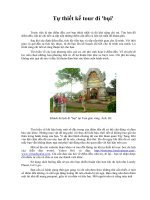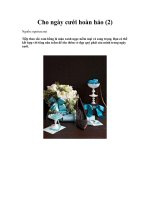Tài liệu 50 Top tips for wedding photography docx
Bạn đang xem bản rút gọn của tài liệu. Xem và tải ngay bản đầy đủ của tài liệu tại đây (654.96 KB, 6 trang )
048
Technique Photo
50
top tips for
wedding photography
The wedding season is upon us, so sharpen up your skills with some insider knowledge from
the professionals.
Karl Foster
speaks to fi ve of the UK’s leading wedding photographers, each of
whom has wisdom borne of long experience
Summer light too harsh? Turn it to your
advantage by making shadows a feature
of your photograph
JOE D MILES
THE SPONTANEOUS APPROACH
■ www.onlineweddings.co.uk
Joe D Miles of ImageCapture is one of the
photographers with Online Weddings and he
uses digital cameras on assignment. He aims to
capture spontaneous images that create an
accurate portrayal of the wedding day. His
approach is to be amicable, fi tting in with and
adapting to the occasion.
3
Pose the bride
For fl attering images of a bride, make sure she doesn’t have her
arms bent (a slight bend is best, but not straight) while holding her
bouquet. If possible, ask her to create an ‘S’ bend with her body, similar to
the way fashion models pose. Look through women’s magazines like
Vogue and Cosmopolitan to see how the models pose to get an idea.
Techniq
1
Use a wide aperture
The use of the widest aperture that your lens
permits (for a narrow depth of fi eld) can create
a very appealing effect for wedding photography,
keeping your subject in focus while making the
background blurred – although you need to be sure you
focus accurately.
2
Try slow-synch fl ash
If using fl ash, try as slow a shutter speed as
possible – 1/15th to 1/25th second, say – to
make the most of ambient lighting. Try panning with
moving subjects while you fi re the fl ash to freeze the
subject and blur a distant background.
4
Look for lines
Try to make the most of strong architectural
lines, such as pillars, for backdrops to your
wedding photographs. Remember, if you sort out the
background, the foreground falls into place to create
the perfect composition. Scout out the venue
beforehand to see which architectural elements might
work best.
5
Use light
patterns creatively
If there are any interesting light patterns outside
the church or register offi ce, you can use them to
add impact and drama to your images. Be aware,
however, that such patterns may come and go as the
day progresses, so you may have to work quickly to
capture them.
6
Frame the couple
When taking pictures of the bride and groom
with their bridal car, try being creative by using
the windows to frame them, or even jump inside the
car, if it’s OK with them
7
Tilt the camera
Camera tilt adds a sense of motion to an image.
This works on some shots very well – you
don’t have to always keep the camera landscape or
portrait format, be adventurous and align the
composition lines at diagonals in the image to create
impact. As with all techniques don’t over do this – one
or two images is ample.
8
Find the shade
If you’re shooting a wedding on a day with
very strong sunshine, try to move the coup
or group into the shade for a better exposure, usin
fi ll-in, or forced fl ash to balance the scene. You’ll fi
the fi ll fl ash setting by cycling through the camera
fl ash modes.
9
Add some blur
Try experimenting with pictures of the fi rst
dance using a very slow shutter speed to g
your images a sense of movement. And, if possible
only ambient light to accentuate the mood. Again
may need to increase the ISO sensitivity of the cam
– although noise will become more obvious in dar
indoor conditions.
10
Use a Strobeframe
fl ash bracket
Attach your fl ash unit to a Strobefra
bracket to lift the fl ash a few inches above the lens
eliminating shadows on the subject. The frame
works on a hinge mechanism and enables you to
move the fl ash for portrait shots or landscape form
shots accordingly.
050
MARK ROBINSON
THE LONG LENS APPROACH
11
Look the other way
Weddings don’t just happen in front of
you. Look around for other photo
opportunities that may be behind you. After all, you’ll
be looking at what your subjects can see, so if you’re
aiming to capture their memories of the day, look at
what they’re looking at.
13
Go low
Try shooting from a low vantage point.
Avoid crouching on your haunches,
however. Such a stance makes you unsteady and you
may fi nd your shots ruined by camera shake. If the
ground is dry, kneel down, or even lie down, in order to
stand a better chance of keeping the camera steady.
14
Wait a second
Let other people take their photographs
and then capture the subjects as they
relax. Formal, posed shots are OK for the record, but
when aiming to capture the emotion of the event,
people come across better in photos when they’re
happy, relaxed and unworried about people taking
pictures of them.
15
Add grain
Grain can add atmosphere and lack of
fl ash can keep attention from you.
The last thing you want is for a fl ash to distract the
wedding guests, drawing attention to yourself. The
high ISO settings used in low-light photography may
induce noise into the photos, which can give them a lot
of character.
16
Try a telephoto
Long lenses keep you out of the action
as an observer. They also create
interesting perspective effects, which can add drama to
photos. Be careful to avoid camera shake that can be
induced when wielding such lenses – a sturdy tripod is a
handy accessory in such situations.
17
Make friends with
the organisers
They know what’s actually happening, as
opposed to what should be. The organisers can tip you
off about who’s going to be where and when, so it’s
wise to consult them in order to be in the right place at
the right time.
18
Don’t be intrusive
If someone doesn’t want their phot
taken, leave them alone. There’s litt
point in taking shots of people who don’t like bein
front of the lens. They’ll not look comfortable and
you could end up causing offence. With experienc
you’ll get to recognise the signals that the camera-
give out.
19
Listen for laughter
Weddings are happy occasions, so
an ear out for laughter. Shots in wh
people look happy and relaxed work very well, so
you ears as well as your eyes to monitor the dynam
the wedding party and move in on where the
merriment’s taking place.
20
Use the wind
If it’s windy, face people into the w
and get lots of movement. The brid
dress in particular can look wonderfully dynamic w
there’s a breeze – its lines will fl ow out with the
movement of air. However, if you’re using a came
with interchangeable lenses, get out of the wind w
you’re changing them to avoid dirt blowing into th
camera body.
■ www.markrobinson.co.uk
Mark Robinson likes to remain unobtrusive at
weddings, employing long lenses to zoom in on
action. He works alone, although he’s happy to
work alongside a traditional photographer who
c
serve as a useful distraction.
12
Pay attention to detail
Look for the small stuff as well as the big picture. Often,
details may go unnoticed by the wedding guests, and yet
when they see a detail shot, memories will come fl ooding back. So be
aware of everything around you and don’t be afraid to photograph it.
You’ll not be wasting any fi lm, after all…
ANDREW JOHN
THE CONSIDERED APPROACH
■ www.andrewjohnphotography.co.uk
Andrew John’s tagline is ‘your wedding, your style’. He’s won numerous
photographic awards for his unique wedding photographs and for his other
speciality, portraits. As with many pro wedding photographers, he offers a
service which enables people to view and buy images online.
Techniq
22
Smile a lot
If you smile at people, they smile back,
so make lots of eye contact. Don’t hide
behind your camera. Someone with a big lump of
technology permanently attached to their face can be
off-putting and you’ll likely end up missing a lot of
potentially excellent shots.
23
Give the couple space
After the ceremony, give the couple time
and space to be congratulated. This
helps you when you come to the organised
photographs – people won’t keep coming up and
getting in your way as they attempt to pass on their
best wishes to the bride and groom.
24
Be candid
While the couple are busy being
congratulated, you can go round and
get some candid shots of the guests. They’ll be happily
distracted and therefore more relaxed than when they
feel they have to pose for the camera. The unobtrusive
photographer can have some of the best shots of the
wedding day.
25
Compose subtly
Pre-focus and compose your subject
through the lens, then get their attention
by talking or smiling at them – they won’t know you’re
taking the photograph. When they do realise, they’ll
laugh and you can then take more natural-looking
photographs. The more relaxed people are, the better
the shots will turn out.
26
Go with the fl ow
Don’t fi ght the rain, wind, people and
time. There’s always a way to get round
a problem, so think laterally. As you become more
confi dent and experienced, you’ll develop numerous
ways of making the unexpected play into your hands, so
exercise your problem-solving skills to the full.
27
Plan for rain
If it’s raining, use brollies. It’s handy to
have a white one and a black one in your
car. Get the couple walking with them, kissing each
other and so on. They make excellent props, and can
save your expensive digital camera from a soaking,
which is unlikely to do it much good.
28
Use the crowd
If people are in the background in
places, just let them be there.
Sometimes it’s good to take pictures of strangers
wishing them the best – take a look at wedding al
on Andrew John’s website titled ‘beach burbo ban
was supposed to be a clear beach, but when he go
there it was packed with people!
29
Manage your time
You should always have enough tim
you don’t, you didn’t ask the right
questions at the consultation. Be aware of the sche
of the day, how you’re going to get from A to B an
where the wedding party will be and when. The
disorganised photographer will miss out on key
moments, so don’t let it be you.
30
Enjoy yourself
Wedding photography can be a lo
fun, but not if you’re fretting abou
camera or the light. Relax and have a good time, j
the rest of the attendees are meant to be doing. Y
may fi nd that your photography improves as a res
21
Consult beforehand
Always have a pre-wedding
consultation with the couple to get to
know them and fi nd out what they want fi rst. It’s
their day, not yours, so it’s wise to have a clear idea
of how they envisage the occasion. Be polite and
don’t promise anything that you can’t deliver.
052
TONY @ DOCUWEDDING
THE REPORTAGE APPROACH
■ www.docuwedding.
Tony is a fully qualifi ed photojou
regularly works for national broa
newspapers and magazines; hen
true expert at reportage photogr
aims to be unobtrusive, capturin
day without ordering people aro
Technique Photo
31
Use your inside
knowledge of the family
to get shots
If some relatives haven’t seen each other for 20 years,
a shot of when they fi rst meet at the church could be
very emotional. Think about the attendees and how
they get on, then use that knowledge to plan your
shooting schedule.
32
Avoid shooting when
people are eating
Don’t take pictures of people eating.
They never look good and no one will thank you for it.
You may as well pack away the camera during the meal
and have some food yourself while you wait for the
speeches, which provide far more opportunities for
good people shots.
33
No chimping
Don’t ‘chimp’ after each shot (chimping
is looking at the camera’s screen to check
your pictures). It uses up the batteries and takes your
eye off the action. You’re better off reviewing the
photos en masse occasionally, being careful to delete
only those that you can’t feasibly use.
34
Bounce the fl ash
When shooting indoors, bounce your
fl ash off the ceiling and balance the
exposure with the ambient light. Bounced fl ash is far
more diffuse, so you won’t end up with those harsh
shadows that are characteristic of amateur snaps.
36
Take your own confetti
To make sure you get a good confetti
shot, take your own confetti. Frame the
shot and throw the confetti high in the air, not at the
couple. Try a small aperture (f11), slow shutter (15th)
and fi ll-in fl ash. Just make sure the wind isn’t blowing
towards you, or you’ll look like an idiot.
37
Listen for stories
When mingling with the guests listen
out for someone telling a story. There
are typically numerous characters at the wedding, each
with something to say, so let them warm up the crowd
for you and be ready to capture their reactions.
38
Edit ruthlessly
When you get back home, edit the
pictures then edit them again. Remove
any shots in which the bride and groom don’t look at
their best. Retouch any blemishes from their faces, and
so forth. Then edit the pictures again – only let people
see the best shots, not hundreds of average ones.
39
Don’t let your came
sharpen the shots
Turn off any automatic in-camera
sharpening. This is best done on the computer afte
you’ve resized the images. If possible, always shoo
RAW format. This transfers the data from the imag
chip directly to memory without compressing it,
although the fi le sizes will be much larger than wh
shooting with JPEG capture, so you’ll need high-
capacity memory cards, or a portable storage devi
copy your images onto over dinner…
40
Underexpose in
bright light
In bright sunlight, try to retain the
in the bride’s dress by underexposing by 1 EV and
bringing the shot up to the correct exposure on the
computer. Digital cameras have excellent dynamic
range, so shadow detail should be recoverable – it’
highlights which is where they tend to have proble
Again, shooting in RAW as opposed to JPEG really
helps in this situation.
35
Tell a story
Adopt a photojournalistic approach – look for pictures th
tell the story of the day. The classic way is to get three
pictures of each moment, not necessarily taken at the same time. For
example, a close up of the cake, a medium shot of the couple cutting th
cake and then a wide angle of the guests’ reactions.









